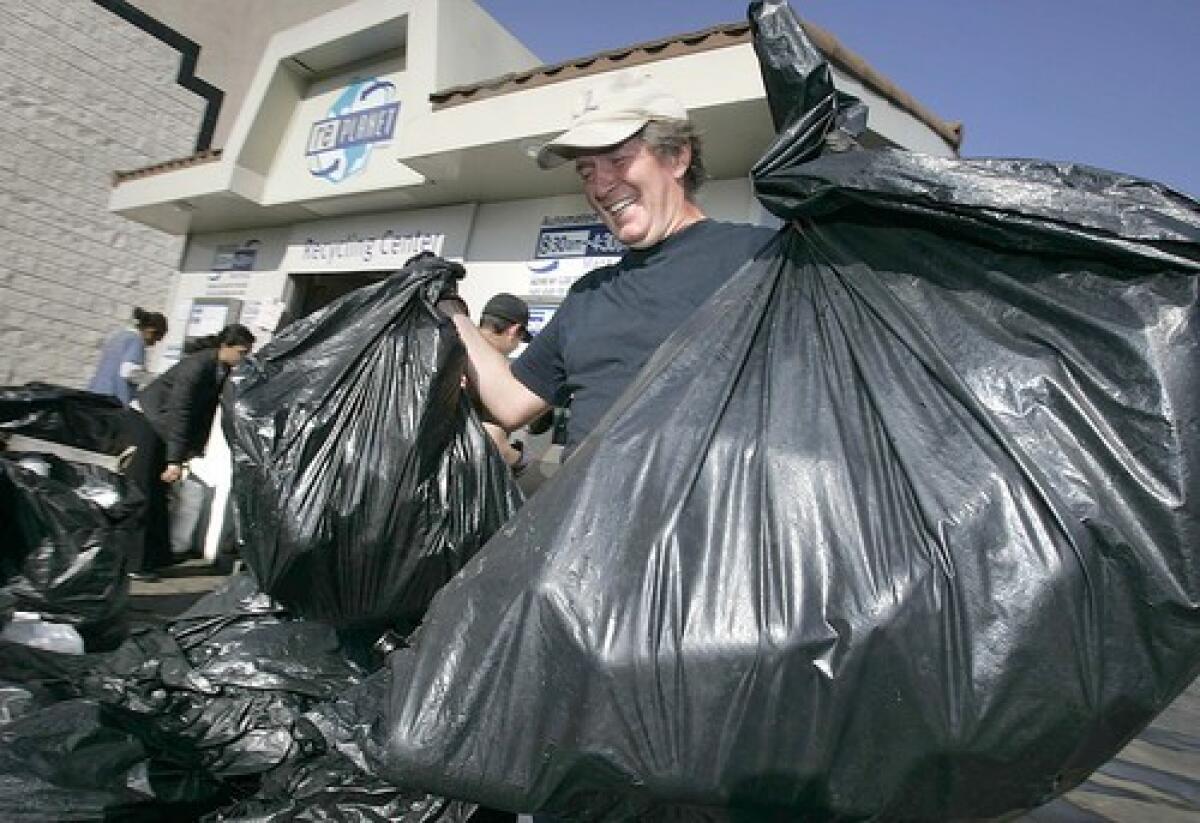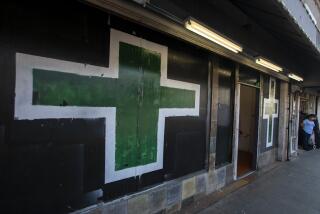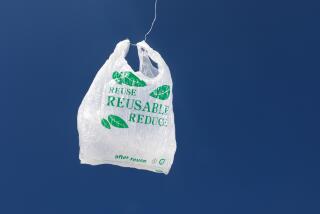More Californians cashing in on recyclables

Diane Schoolsky is a recycling pro. She opens up the hatchback trunk of her silver Prius in the Ralphs parking lot near Hancock Park, and quickly sets about relieving it of 11 paper bags and two white garbage bags that overflow onto her back seat.
The pickings represent 12 days worth of recyclables, for which she earned about $22. Schoolsky, 60, has done this for decades. “It’s a good way to recoup money you’re already shelling out,” she said.
FOR THE RECORD:
Recycling: An article in Monday’s California section about beverage container recycling reported that the California redemption program generated $200 billion to $300 billion in unclaimed refund value. The program generated $200 million to $300 million in unclaimed refund value. —
Environmental experts say more Californians are thinking like Schoolsky and getting into the game, helping break the state’s record recycling levels this year.
Californians recycled more than 6.9 billion beverage containers in the first half of 2007, up nearly 800 million from the same period a year ago, the state’s largest recycling-rate increase in the last 15 years, according to a recent study released by the state’s Department of Conservation. And officials think they know why.
In January, the state increased the California Refund Value to a nickel for small beverage containers and a dime for large ones. The respective one- and two-cent hikes, they believe, may have changed a lot of perceptions.
“If you see four pennies on the ground and you’re walking on the street, are you going to bother to pick them up?” asked Mark Murray, executive director for Californians Against Waste, a statewide environmental organization that focuses on recycling. “Whereas you see a nickel or dime on the ground, you’re likely to pick that up. The same thing goes to just seeing that value in a can and thinking, ‘I’m tossing a nickel in the trash.’ ”
Officials can’t know for sure why recycling has increased -- no one asks why people recycle or when they started -- but a view from the ground lends credibility to the notion that nickel-and-diming consumers has worked. Seven in 10 deposit containers are now redeemed, according to the study.
Maria Rivera has felt the weight of the change in her arms. She bustled about at a recycling center near Hancock Park on a recent weekday, lifting blue bins and sorting and crushing water bottles and soda cans. Neon-orange plugs in her ears muted the crashing, crunching and banging that surrounded her. She brusquely pointed to a hefty wad of receipts recording each day’s gross weight (more than 2 tons) and daily payouts (upward of $1,000) during the last month.
Rivera sees more of everything these days: more plastic, more glass, more aluminum, more people and more money.
Meridith Lanning, 35, a self-employed Hollywood resident, said she wouldn’t be recycling if a friend of hers hadn’t mentioned making $7 from a month’s worth of recycling. That was three months ago. She’s been collecting her refunds ever since.
“I’ve already paid the money; I might as well get it back,” she said. Lanning had always recycled in her curbside blue bin, which allowed scavengers to redeem her bottles and cans, but she never thought of doing it herself. “If you buy a six-pack of something, that’s 60 cents,” she said. “It’s real money . . . and we could all use extra cash. The economy hasn’t been kind to all of us.”
Last week, on her second trip to a recycling center, Lanning brought four medium-sized bags filled with bottles and cans that once held juice, water and alcoholic beverages. After initially forgetting to tap the green button and grab her receipt to claim her refund -- “Can you tell I’m new at this?” -- she made $4.80.
The 6 percentage point increase to 71% in the beverage container recycling rate comes after state officials worried that Californians were buying more plastic bottles, especially water bottles, and recycling fewer.
In 2003, state officials turned to a media-heavy campaign and, in the last four years, has raised the refund value twice. Recycling experts believe that the most recent raise seemed to show that the difference between four cents and a nickel was apparently more than a cent.
“The signal that recycling is worth a nickel, that recycling is worth a dime, conveys a sense of value,” Murray said. “It suggests to the public, recycling is not just about a couple pennies, and as symbolic and simplistic as it sounds, I do think it makes a difference to the public in making them feel they’re doing something important.”
In Wolfgang Braendle’s case, the state is preaching to the choir. At first glance, Braendle looks like he works at the recycling center, from the dirty white cap atop his head to his grime-streaked white sneakers. Piled around him were seven 45-gallon trash bags, from which he expertly sorted out wine bottles and soda cans, spinning them onto the conveyor belt with a dexterity his fellow recyclers have dubbed a “magic touch.”
A retired software company executive with three master’s degrees, Braendle moved to the United States from Germany seven years ago. He said many Americans seem to attach a social stigma to those who go around with bags full of bottles and cans. Braendle, 59, said Germany got over that prejudice 20 years ago.
American recyclers, he said, could use etiquette training.
“They’re very aggressive here: ‘Oh, you have a lot [of bags], I want to go in front of you.’ But when you go in the bank and want to pick up $10, and someone wants to pick up $1 million, you don’t say, ‘I want to go in front of you.’ You say, ‘Oh, he’s a rich guy.’ And that’s the difference.”
Braendle has been a recycling devotee for the last 2 1/2 years, spending about four to eight hours most days gathering and turning in bottles and cans from neighbors and friends who often do not have the time or are not willing to parse the contents of their curbside bins. On a good day, he makes as much as $150, he said. Recently, his seven bags cashed out at $78.
Most people “don’t know the difference between blue, black and green; they think everything goes into one bin,” Braendle said.
But whether deposit containers go into a bin, or to a recycling center, makes little difference to the state.
The redemption program generates $200 billion to $300 billion in unclaimed refund value that is used to pay for recycling-related education and grants and subsidies to local governments and conservation groups.
An increase in overall recycling has played out in communities across the state, officials say. The city of Los Angeles estimates that it collected 230,000 tons of recyclables, including bottles, cans, cardboard, newspaper and wire hangers, from about 750,000 households this year, up about 10,000 tons from last year, said Neil Guglielmo, a manager of the citywide recycling division within the Bureau of Sanitation.
“When you consider all the plastics we’re collecting, and polystyrene foam, it doesn’t weigh much,” he said. “So you need to have a really sizable increase in the amount of materials to have a change in tons.”
State officials hope Californians eventually recycle at least eight out of every 10 deposit beverage containers they buy.
“It’s such a hard number to get when the number of containers [used] just keeps increasing every year,” said Bridgett Luther, director of the Department of Conservation. “If I was working on the numbers from even 10 years ago, I would have made it. I’d be at 100%. . . . Sometimes it feels a bit like you’re chasing your tail.”
Luther said people such as Schoolsky, who has persuaded her neighbors to leave their recyclables by her car or her condo, help the state battle the rising number of containers used. Schoolsky said her younger sister, who lives in Woodland Hills, urged the five women in her Mahjong group three years ago to start pooling the refunds from their recyclables. The money pays for much of their annual getaways.
“You’ve already spent the money,” Schoolsky said. “Why not?”
More to Read
Start your day right
Sign up for Essential California for news, features and recommendations from the L.A. Times and beyond in your inbox six days a week.
You may occasionally receive promotional content from the Los Angeles Times.






